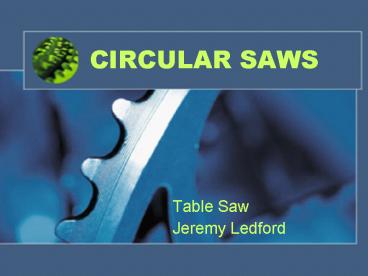CIRCULAR SAWS - PowerPoint PPT Presentation
1 / 32
Title:
CIRCULAR SAWS
Description:
Stacked Dado Head. Wobble Blade. Sliding Tables. Great for ... Dado Heads. The same process is used, but the entire assembly must be mounted and sharpened. ... – PowerPoint PPT presentation
Number of Views:879
Avg rating:3.0/5.0
Title: CIRCULAR SAWS
1
CIRCULAR SAWS
- Table Saw
- Jeremy Ledford
2
The Table Saw
- The arbor is the shaft on which the blade is
mounted. - Table saws may be left or right arbor.
- Parts of the saw
- Splitter
- Handwheels
- Miter gauge
14-4
3
Guards
- Saw guards are NOT foolproof and their use will
NOT completely eliminate the hazards of the table
saw operation!! - Guard with and without splitters.
P 253
4
Saw Blades
- Common Types of Blades
- Rip, Crosscut, Rough Cut, Combination
- Rip Blade teeth are filed straight across to
form chisel shapes. - Crosscut Blade teeth are filed to a point.
- The NUMBER OF TEETH determines the coarseness of
the cut and the rate of feed. - More teeth need to be feed slowly. WHY?
5
(No Transcript)
6
Carbide-Tipped
- Strong tip is added to the blade.
- Lasts longer than conventional blades.
- We use a Combination Carbide-tipped blade.
7
Safety Rules
- Check the blade
- Use the guard for all operations whenever
possible. - Set the blade above the wood 1/4? 1/8?
- Tip of carbide blade
- Stand to one side of the saw when cutting
8
Safety Rules
- NEVER CUT STOCK FREE HAND!
- Turn off the saw before making any adjustments.
- Book states Use a push stick to move scrap
cuttings away from the blade. - Turn off the saw, let it stop, then use a push
stick to remove the pieces.
9
Safety Rules
- When catching stock, only support it, do not push
or pull the stock. - Clear the saw table and place waste cuttings in
the scrap box. - Flying miter cut?
10
Ripping Stock
- Ripping is cutting with the grain.
- Have at least one straight edge to run along the
fence. - NEVER reach over or around the saw to catch
short pieces. - Use an auxiliary fence when ripping thin strips
or veneers to prevent the stock from slipping
under the fence.
11
Crosscutting
- Crosscutting is cutting across the grain.
- Move the fence out of the way.
- Never use the miter gauge and the fence at the
same time, unless you are using an auxiliary
fence.
12
Crosscutting
- To cut small pieces with a miter gauge, clamp the
stock to a larger piece as shown.
13
Dado Head
- The fence can be used with the miter gauge in
this situation. - Stacked Dado Head
- Wobble Blade.
14
Sliding Tables
- Great for large piece, i.e. plywood sheets
- Tru32 Cabinetmaking
15
Sharpening Blades
- Certain equipment is needed to completely sharpen
circular saw blades, however, they can be filed a
number of times before they must be fully
re-sharpened. - Page 234 in your text.
16
Sharpening Blades
- Jointing rounding the blade so all the teeth
are the same height. - Clamp an abrasive stone to the miter gauge.
- Raise the blade till it touches.
14-47
17
Filing saw teeth
- Mount the blade in a filing clamp.
- File teeth
- Rip blades straight across
- Combination teeth 15 degrees
14-50
18
Setting Teeth
- Blades must be set after a number of sharpenings.
- Setting the blades keeps a saw kerf.
19
Gumming
- Gumming is the process of grinding and shaping
the saw gullets.
20
Dado Heads
- The same process is used, but the entire assembly
must be mounted and sharpened.
21
CIRCULAR SAWS
- Radial Arm Saw
22
Radial Arm Saw
- An advantage of the radial arm saw is that the
board is held against the fence while the saw
moves across the board. - This prevents kickbacks and reduces stock
slippage.
23
Safety Rules
- Support the ends of long boards.
- Always return the saw to the rear of the table
after making a cut. - Keep a margin of safety, 6in
24
Crosscutting
- Control the feed rate
- If the feed rate is not controlled properly, the
saw will advance too rapidly and climb over the
work. - Miters, bevels, and compound miters can be made
on this machine.
25
Ripping
- Ripping can also be performed on this saw.
- Make sure to feed the stock into the blade.
- Dados and grooves.
26
CIRCULAR SAWS
- Portable Circular Saw
27
Parts of the Saw
28
Portable Circular Saw
- Used extensively by carpenters in framing and
construction. - Can be used in the lab for cutting rough sizes.
- Size is determined by the diameter of the largest
blade it will carry.
29
Safety Tips
- Support the stock so the kerf will not close.
- Clamp small pieces in a vise.
- Adjust the depth of the cut according to the
thickness of the stock, 1/8 deeper. - Do not lay the saw down until it stops moving.
- DO NOT TRUST THE BLADE GUARD!
- Dont create bad habits, co-worker story.
30
CIRCULAR SAWS
- Miter Saw or Chop Saw
31
Miter Saw
- Text Power Miter Box Saw
- Good for cutting miters on trim and molding.
32
Compound Miter Saw Frame and Trim Saw
- Saw pivots right or left up to 60 degrees
- Supported on a pair of overhead shafts or guides































